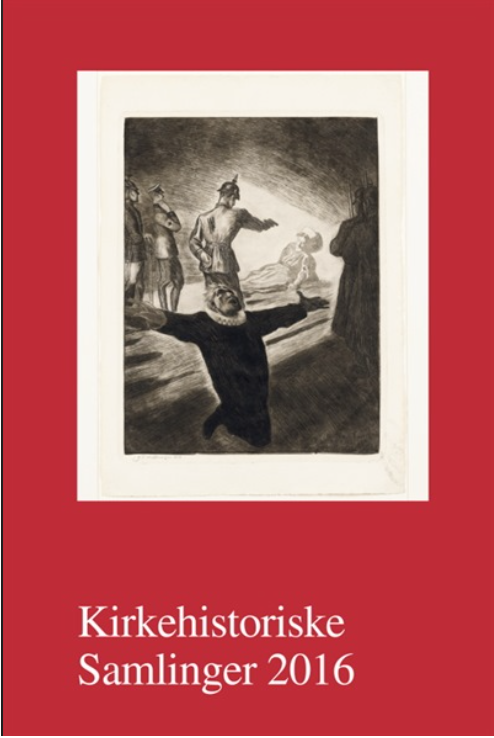»Hans Tausen forkynder Lutheri Lære«: August Thomsens maleri og Hans Tausen i 1800-tallets danske malerkunst
Publiceret 25.02.2025
Citation/Eksport
Copyright (c) 2016 Tidsskriftet Kirkehistoriske Samlinger

Dette værk er under følgende licens Creative Commons Navngivelse – Ingen bearbejdelser (by-nd).
Resumé
Tidligere fandt Nationalmuseets folk ofte et hengemt stykke middelalderlig kirkekunst på kirkernes lofter. Forfald og ændringer i tid og smag foranledigede kirkeværger og andre til at flytte gammelt inventar på loftet og købe nyt og tidsvarende inventar til kirkerne. I dag er det vel ikke længere muligt at gøre sådanne fund af middelalderligt kirkeinventar på lofterne. På den anden side: Moden skifter fortløbende. I det 20. århundrede blev meget af den kirkekunst, der blev produceret af mindre kendte danske kunstnere, efterhånden anset som smagløse pasticher. Og så røg de på loftet. Denne skæbne overgik bl.a. kunstmaleren August C.V. Thomsens (1813-1886) hovedværk: Hans Tausen forkynder Lutheri Lære fra 1849, der netop er konserveret og klar til reformationsfesten i 2017.
Summary
»Hans Tausen preaches Luther’s teaching«. August Thomsen’s painting of Danish Reformer Hans Tausen (1849).
One of the Danish painter August Thomsen’s major works is his painting of the leading Danish reformer Hans Tausen (1494/98-1561)
preaching the new evangelical doctrine in Viborg. It was completed in 1849 and later placed in Helligåndskirken (Church of The Holy Spirit) in Copenhagen until it was removed and stored out of sight in the middle of the 20th century. It has recently been restored and this article describes the genesis of the painting, the motive and the quarrels about the payment of artist Thomsen, when the painting finally was finished.
August Thomsen (1813-1886) was trained at the Royal Academy of Fine Arts in Copenhagen, yet did not achieve a break-through on the Danish art scene with his early Romantic historic pieces. Instead he managed to become quite popular as a religious painter of the Nazarene school and delivered several paintings for altar retables to Danish village churches. Thomsen’s religious style and inspirations can also be identified in the painting of Hans Tausen. Here the reformer is shown in almost the exact moment of conversion to Lutheranism given that Hans Tausen is visualized as a monk preaching the Gospel. His whole appearance and posture mirrors Thomsen’s contemporary paintings of Jesus and probably shows connotations to the representation of Saint Ansgarius, ‘The Apostle to the North’ and other religious figures.
»Hans Tausen preaches Luther’s teaching« was originally commissioned by the Danish prince and then governor of Funen, Christian
Frederik in the late 1830s. The genesis of the painting however is even longer and the motive can be traced back to an art competition launched by the Danish Art Society on occasion of the third centenary of the Danish Reformation in 1836. At that time Hans Tausen was known and honored as ‘The Danish Luther’. Thomsen did not participate in the competition, but sources found in The Danish National Archives show that Prince Christian Frederik ordered the painting of Tausen with a motive similar to one of the subjects from the 1836 competition. Thomsen did not finish the painting before the death of former Prince Christian Frederik, King Christian VIII of Denmark in 1848. The new King Frederik VII acknowledged Thomsen’s agreement with the former king, yet either he or one of his officials initiated an investigation and valuation of both the artistic and economical value of the painting at the Royal Academy. The commission, whose report has not been traced, was not satisfied with the painting; nevertheless Thomsen managed to find supporters, who approved his claims. The sources too indicate that Thomsen finally received his wage, though the painting of Hans Tausen was soon donated or sold to a pastor at the Copenhagen Church of the Holy Spirit. As restored it can once again tell the legend of ‘The Danish Luther’ preaching under open sky to the citizens of Viborg, thus introducing the doctrine of Luther to the Danes. In that respect, Thomsen’s painting is a significant monument of the Danish 19th century veneration of its most popular and cherished reformer.

